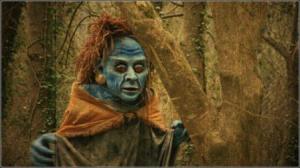(So here I am, talking once again about a Christian thing that, for me, merges with Pagan things. I should really give up and call this ‘Leithin’s Interfaith Blog’.)
I adore icons. Especially Byzantine and Russian ones.

Early Byzantine icon of Mary
Icon simply means ‘image’, but the term is generally used to mean sacred imagery, particularly of Eastern churches, where icons are painted in Byzantine or Russian styles[1]. Orthodox and Roman Catholic churches are full of icons. If you’ve only ever been in bare, late modern churches, in their dull community-centre-like buildings with no pictures or representations of the Divine, you’re missing out.

Saint Sophia and her daughters – Byzantine (picture from Wikimedia)
There’s so much to say about iconography that entire books have been written about it. Here’s just one thing: images of Mary and the child Christ, probably based on earlier images of Isis and Horus [2].

Statuette of Isis nursing Horus – Late Period-Ptolemaic Period, Metropolitan Museum of Art

Isis nursing Horus. Penn Museum. Photo by Jocelyn Dale, Flickr (CC)

Mary and Christ – Byzantine icon
Protestant churches don’t like icons, or images of God in general. Their rejection of them is based on the second of the Ten Commandments: “You shall not make to you any graven image, or any likeness of any thing that is in heaven above, or that is in the earth beneath, or that is in the water under the earth.” In short: don’t make idols. There’s a long history of Protestant resistance to Catholic/Orthodox iconography that goes along with that. Anglo-Catholic churches (the ones I used to go to) have re-embraced iconography. And there’s always this tension there – this oft-repeated mantra of it’s not an idol, it’s an icon. But I looked at the statue of Mary in my church and didn’t see ‘something that points to Mary’. I saw Mary. To all intents and purposes, it was a beautiful, glorious idol to me.
And here’s a funny thing. In Christianity, I was a huge fan of icons, especially traditional ones, like those above. But when I started honouring my Gaelic gods, in a religion/spiritual path that’s all in favour of representing deities with idols or pictures, I suddenly didn’t want to. I was no longer forbidden from making a “graven image” of my gods – in fact, it was encouraged – but now, I couldn’t do it. I had pictures of the Morrigan and Arianrhod for a while, but they became… insufficient. It was like I was trying to capture a divine essence that cannot be caged in images.
I still have this picture on my wall above my deity altar:

Relief from the temple of Sulis Minerva at Bath. Photo by Mary Harrsch, Flickr (CC)
It’s from the shrine of Sulis Minerva, in Bath, but it’s not the goddess – it’s probably either a representation of local land spirits, or worshippers. For me, it captures the essence of Sulis Minerva – not in an image of her, but in the faces of those who honoured her.
And, yes, part of it is the difference between this and this. There are hundreds of years of tradition and spirituality behind each Eastern Orthodox icon. The artwork is some of the most beautiful that you will ever see. Each one says, my god (or honoured ancestor) is worth some serious craftswork. Now, admittedly, neopagans don’t get commissions of a lot of money from a rich church allowing them to spend months, maybe more, on each image they create of their god(s). And I’m sure there are some serious craftspeople out there, making absolutely beautiful images of their deities. I just haven’t seen the ones that call to me (yet). And I think that’s mainly because – well, how can a statue of Lugh compare to this?

Photo by ghewgill – Flickr (CC)
And how can a painting of Arianrhod compare to this?

Corona Borealis – by Cristóbal Alvarado Minic – Flickr (CC)
And how could an image of Cailleach Bhearra ever compare to this?

Healy Pass, Beara Peninsula, Cork
I find the gods in the things that embody them – the trees, the sea, the wind, the mountains, and the simple little candles that stand for each deity on my altar. So when I learnt, from writers like Miranda Green, that the Celts probably didn’t have much in the way of physical representations of their gods, at least before the Romans arrived, it all made a lot more sense. Ronald Hutton says it’s not clear whether or not the Gaelic and Brythonic tribes honoured the land as a manifestation of deity or the divine. And certainly, not all the Gaelic gods are land deities. But Cailleach Bhearra is a mountain goddess and Manannan is a sea god – and while they may not quite be gods of those things, they are those things. Bhearra is as much the mountains as the stones that make them up. Manannan is as much the sea as the waves and the gulls and the shoreline.
I suppose I’m talking about a kind of polytheistic animism. I’m good with that. My icons are in the world around me.
But I’ll always love the reminder of forbidden, illicit worship of the divine embodied in *things* that Christian iconography first pointed me towards. The icon was my first way in to understanding that the divine is creation, and creation is divine.

Statue of St Gobnait. Ireland

Statue of Mary, at the side of the road in Co Cork, Ireland. You can see these on every corner in rural Ireland.
[1] John R. Hinnells, A New Dictionary of Religions
[2] Victor Lasareff (1938), ‘Studies in the Iconography of the Virgin’. The Art Bulletin.













![ADF cosmos sigil [1]](https://leithincluan.wordpress.com/wp-content/uploads/2013/03/world_tree.jpg?w=83&h=240)

